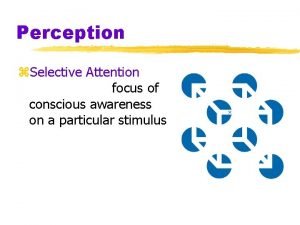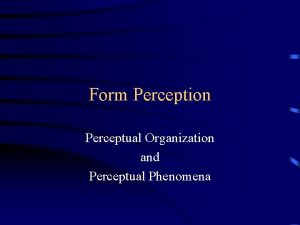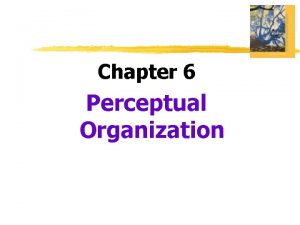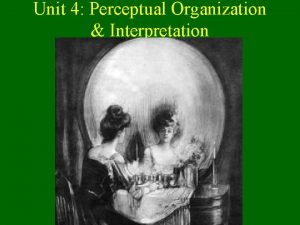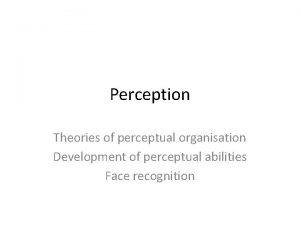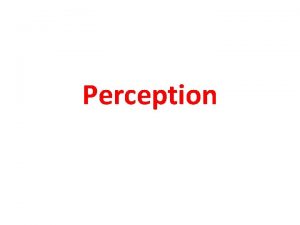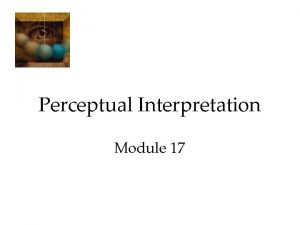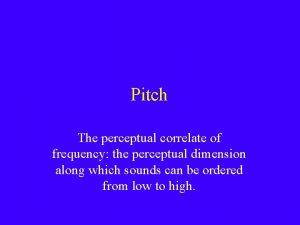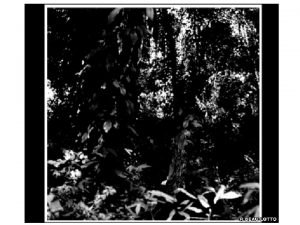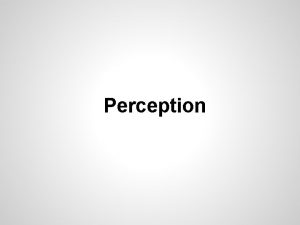PERCEPTION Rules of Perceptual Organization Perception the way












- Slides: 12

PERCEPTION

Rules of Perceptual Organization ■ Perception- the way we organize and make sense of all our sensory impressions ■ Closure- the tendency to perceive a complete or whole figure even when there are gaps in what your senses tell you ■ Figure-ground perception- is a type of perceptual grouping which is a vital necessity for recognizing objects through vision

Cntd. ■ Proximity- tendency to group together visual and auditory events that are near each other ■ Similarity- tendency to group together elements that seem alike ■ Continuity- tendency to group stimuli into continuous patterns

Perception of Movement ■ To sense movement, humans need to see an object change its position relative to other objects. ■ When you pull up to a red light next to another car, and the light then turns green. The car in front of you begins to move forward. For a brief second it may seem as though you’re not sure which vehicle is actually moving. ■ Early scientists believed that the sun revolved around the earth, because they couldn’t tell they were the ones actually moving. They would have needed to be in outer space to actually see they were wrong! ■ So how you can tell which vehicle is moving? Look for objects that you know are stable, such as buildings and trees.

Stroboscopic Motion ■ Defined as- the illusion of movement ■ Is produced by showing the rapid progression of images or objects that are not moving at all ■ Examples include flipbooks and movies

Depth Perception ■ Depth meaning the distance away ■ For example, there is a glass of juice on the table. In a split second you can reach out and get it with little thought because of depth perception. ■ Cues include perspective, clearness, overlap, and shadow

Perceptual Constancies ■ If I see you from all the way down the hallway and you continue to walk towards me, How do I know that you are not actually growing by the second? Experience! ■ Each person’s experience creates perceptual constancies: – Size – Color – Shape – Brightness

■ Size Constancy- the tendency to perceive an object as being of one size no matter how far away the object is. ■ A dog 20 feet away looks as big as an insect an inch from your face. Size constancy is what tells you they’re not actually the same size. ■ How do we know we learn this? ■ A study of the Mbuti people of Africa. The Mbuti people lived in a dense forest. A British psychologist took the guide into a wide open plain, where they saw buffalo in the distance. The guide mistook the buffalo as insects. Why? ■ Color Constancy- the tendency to perceive objects as keeping their color even though different light might change the appearance of color ■ If we went to a movie and I was wearing a red shirt, even while the movie was playing, you’re brain would still tell you my shirt is red even though it looks darker

■ Shape Constancy- the knowledge that an item has only one shape no matter what angle you view it from. ■ If you look at a closed door it looks like a rectangle, but it appears to change shape if you open it. But because of shape constancy we know it actually hasn’t changed. ■ Brightness Constancy- the tendency to perceive an object as being equally bright even when the intensity of the light around it changes

Visual Illusions ■ Do your eyes sometimes play tricks on you? Actually its your brain’s fault. ■ Muller-Lyer Illusion ■ Ponzo Illusion

Perceptual Constancy Organizer Provide real world examples for each perceptual constancy and complete on your own sheet of paper or in notebook. Perceptual Constancy Size Constancy Color Constancy Brightness Constancy Shape Constancy Example

Questions 1. What is figure ground perception? 2. Describe size constancy. 3. How might someone from another culture who had never viewed anything from a high elevation perceive objects on the ground seen from the top of a skyscraper? 4. Why do you think people try to fit the pieces of information they perceive into a familiar pattern? 5. Some psychologists claim that we only perceive that to which we pay attention. Other psychologists say that we perceive a great deal more than we pay attention to. With which viewpoint do you agree? Write a paragraph in which you support your position with a real life example.
 Perceptual perception
Perceptual perception One way table and two way table
One way table and two way table Two way anova
Two way anova What is a threaded binary tree traversal?
What is a threaded binary tree traversal? Perbedaan one way two way anova
Perbedaan one way two way anova Anova hypothesis examples
Anova hypothesis examples One way anova vs two way anova
One way anova vs two way anova Two way anova adalah
Two way anova adalah Conventional software
Conventional software This way that way forwards backwards over the irish sea
This way that way forwards backwards over the irish sea Walk this way talk this way
Walk this way talk this way Process organization in computer organization
Process organization in computer organization Block arrangement essay
Block arrangement essay
